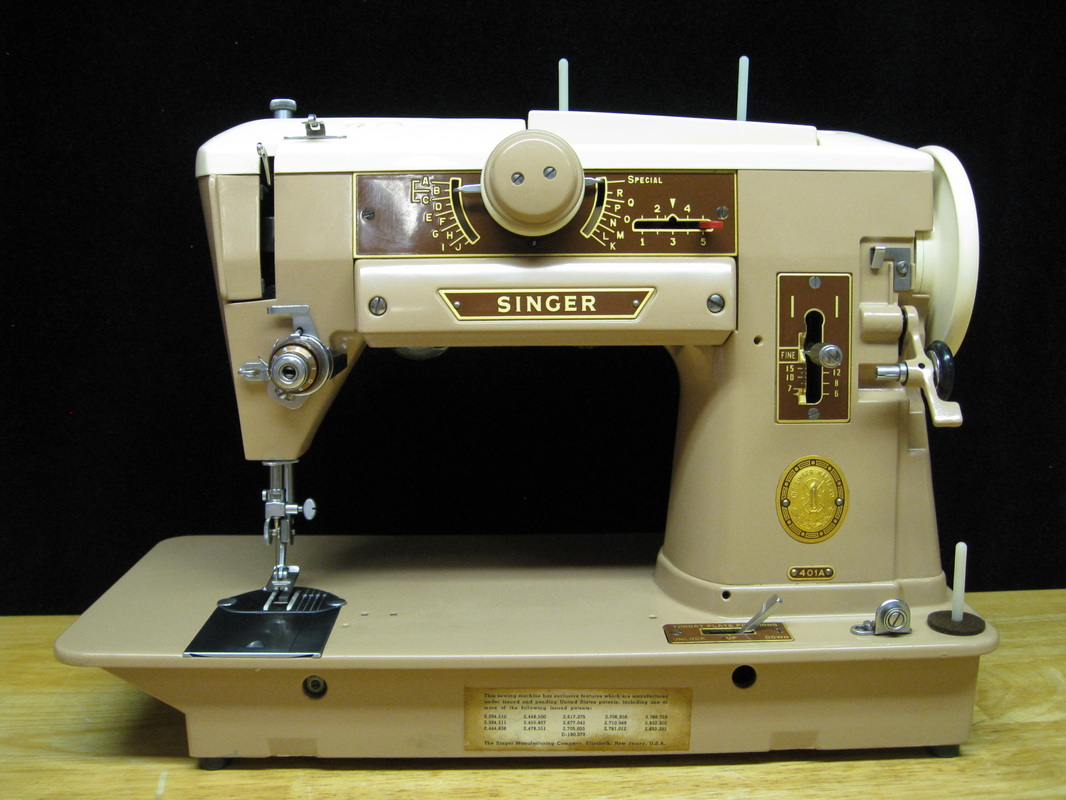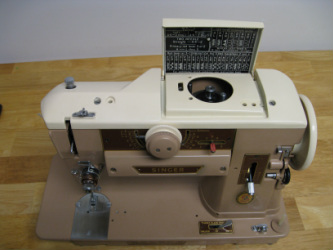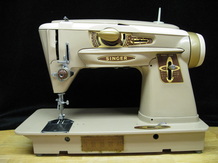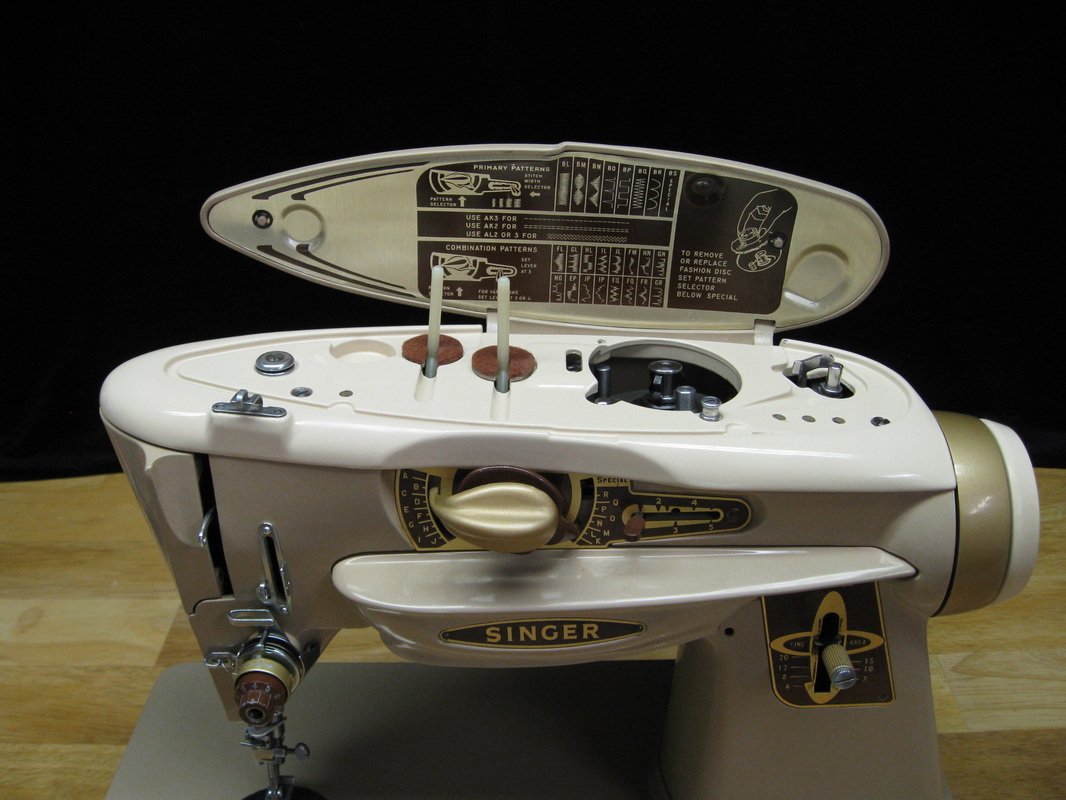35 Comments
Hi,
Reply
OldSewinGear
9/18/2012 12:56:12 pm
Without seeing the machine it's hard to answer definitively, but the first and easiest thing to check is that you are using the correct combination for straight stitching.
Reply
Richard Beman
10/1/2013 05:12:18 am
Hello, in regard to your inquiry about the # 500 machine stitch quality. You mentioned that it is satisfactory when you are sewing slowly..That may be an indication the the feed dog height adjustment may need to be modified to raise them a bit higher. This can loosen up as any machine subject to use or age. It is a simple adjustment, but the motor and bracket need to be removed and the
Reply
Hi,
Reply
Warren
1/13/2013 02:59:58 pm
The 500 was the first new machine mom bought in 1962, she still has it, but has not used it in a long time as she mostly quilts, she bought a 401A a while back, and has made that her main machine, she now has 2 of the 401A's and a featherweight for her quilting. When it goes in for its semi annual check up, the Sewing machine repair man always comments on the 401, that the 401 is a good machine.
Reply
OldSewinGear
3/3/2013 12:37:05 am
Thank you for sharing your family's experience! Sewing repairmen really love the 401 because it's virtually indestructible and almost anything can be repaired because of the high quality of materials. Your mom is a smart lady! Two 401's, a Featherweight, and a 500! Now THAT's a sewing room!
Reply
Hi Barbara,
Reply
OldSewinGear
3/3/2013 12:39:44 am
Thank you for the update! I'm so glad I was able to help. It is truly amazing how something as simple as a throat plate/needle plate can make such a HUGE difference. But the engineers behind these vintage machines knew what they were doing and they included all those extra gizmos for a reason! I'm just too lazy to use them most of the time!
Reply
Paul Duba
3/2/2013 10:25:58 pm
I have sewn on both (I learned on my mom's 401A and I own a 500A). Can you comment on the little thread puller that is part of the 500A's threading scheme, it gives a little tug to the thread feed on every stich? I get how it works, keeping the spool of thread moving so that the pull-up arm doesn't have to do it through the tension plate. This feature seems both unique to the 500A and to also have not seen daylight again in future manufacturing. Your thoughts?
Reply
OldSewinGear
3/3/2013 12:33:29 am
Paul, thanks for raising this important question. This "extra" thread guide/take-up is one of the 500's more interesting innovations, but was dropped by Singer on subsequent models. I've seen it on one other model, the 411G Slant-o-Matic (see photo on 'Gallery' page) which was a funky hybrid of features from the 401, 400, and 600.
Reply
Kelly
3/9/2013 03:53:26 am
Hi there:
Reply
OldSewinGear
3/10/2013 03:35:12 am
The original Singer foot controls don't have speed settings, but were simply designed to go faster the harder you stepped on them. Not as sophisticated as later electronic controls. Here are a couple of suggestions for sewing at lower speed.
Reply
sara
11/15/2016 08:17:21 am
Does this knee lever concept apply to the Singer 401A slant-0-matic?
Shannon Hunziker
3/17/2022 12:52:42 pm
I have a 301, and I had the same problem with the foot pedal. Zero to a hundred. I found a video on Youtube about how to adjust it. Now you do have to open up the foot pedal to do this. But it was successful, and now it starts much slower than before, with light pressure.
Reply
Shannon Hunziker
3/17/2022 01:10:57 pm
Here's a video about adjusting the 221's foot pedal. I think they're pretty similar.
andy
11/13/2013 02:10:36 am
Hi I was wondering if anyone could help. I would like to know how much I could sell my 401 singer machine for with original manual and case also in excellent condition.
Reply
OldSewinGear
11/13/2013 11:18:51 am
Andy,
Reply
ron
12/3/2013 02:27:32 am
Why I have to help my 401 to get started by
Reply
OldSewinGear
12/3/2013 10:18:59 am
Ron,
Reply
Rebecca
3/1/2015 11:25:27 am
Hi Barbara,
Rita
12/17/2013 11:40:35 am
What a wonderful review! I fell in love with a Rocketeer after watching a couple of youtube videos and have been looking for one with price that is friendlier to my wallet. Well, I am rediscovering the joy of sewing decades after my mom gave my beloved Singer sewing machine, an old treadle, that I inherited from my late auntie (dad's side) to another auntie (her side). I scored a 1940s Kenmore model 117.959 for cheap from an estate sale and have been happy with it. However, the thought of Rocketeer has been bugging me for awhile, though I wasn't sure if I should really invest in one considering my finances a bit tight. Then I came across your review, which prompted me to check CL and, lo and behold, I found a couple of them! One is 503A ($45, no cams/accessories, with table, no clear shots so I can't tell its condition) and the other is 500A ($125, no table, looks very clean). In addition to the Rocketeer, there is also a 401A (accessories + table, originally priced $300, now $150, photo with accessories isn't clear so other than bobbins I can't tell what else is there). I wish I can include the photos of the three Singers here so you may be able to tell me if the asking price is fair.
Reply
OldSewinGear
12/18/2013 10:15:06 am
Any one of the three could be a good buy, depending on condition and accessories. If you're planning on looking at them, I suggest that you look over the 401 checklist on the "cheat sheets" page. It provides some helpful hints on what to look for. It's specific to the 401 but the same principles apply to any vintage slant needle. Hope you find what you're looking for!
Reply
Christy Ray
2/10/2014 09:50:24 am
Hi all ! I just wanted to say I was born in the late 70s and am just now finding out "they dont make 'em like they use to!" I have been dealing with my plastic inards singer with 46 stitch functions that will only sew a strait seem lol found out a cam cracked and that was that !
Reply
OldSewinGear
2/12/2014 12:23:35 pm
Thanks for sharing, Christy! Like you, I was born after the heydey of these magnificent machines and I've really enjoyed experiencing the brilliance of old-fashioned vintage quality. Thanks for visiting, Barbara
Reply
Marianne
3/1/2014 07:12:43 am
Hi, I just bought a Singer 600e and like all of the stitch functions and the fact that it has a metal gears. I keep hearing about how great a 500 is and just saw one at my local thrift shop for $40, and I know I can get the price down to $30. Is the 500 a significantly better machine than the 600e? Or is the retro look the only major difference? Thanks for any help Barbara. I love your site!
Reply
OldSewinGear
3/2/2014 02:40:04 am
Marianne,
Reply
Marianne
3/2/2014 04:13:59 am
Thanks for your help and quick response!
yolande
3/17/2014 12:34:04 am
My singer 401 motor has "died". I am devastated. Where can I get a replacement motor?
Reply
OldSewinGear
3/20/2014 11:19:03 am
Yolande,
Reply
Nelson
2/24/2015 08:34:51 am
There are helpful videos on youtube to show you how to service a motor. While I haven't tried to do it myself, they seem fairly straightforward so that anyone can do it.
Reply
OldSewinGear
3/2/2015 12:04:33 pm
Thanks for the encouragement, Nelson! I agree almost anything can be found on YouTube these days! 6/18/2015 06:51:54 am
Thank you for posting this comparison. I am the proud owner of a 1956 401a, Cinnamon. It is spectacular. Although I love the look of the Rocketeer, function rates higher. Cinnamon sews steady and true and I love the fact that she is all metal. She is also my "forever" machine.
Reply
Lynne
10/26/2016 12:43:25 pm
I bought a Singer 500 last week in a table, all in great shape! Has all accessories and manual. Was serviced by an Amish lady. Paid $25. I have a newer Singer portable, plastic case, etc. thinking I will sell the portable as it moves around when seeing due to vibrations. Is the 500 a good machine and will I be better off with it versus the newer portable.
Reply
Renita D Harvey
2/24/2019 09:20:22 pm
Personally I prefer my older machine to the portable. I have a 401a and 638 Touch and Sew. They have a feel more close to the industrial Juki that I used in the factory where I worked. The advantage to the portable is just that... it's portable. I wouldn't sell it unless of course you don't have space for it because you never know when you may just want to take it someplace.
Reply
Deborah Dauray
8/19/2017 10:52:59 am
I am so excited with my singer 503 and it is stamped 503j on the machine. The manual says 503. I am so happy to find you.
Reply
Leave a Reply. |
News, Reviews,
|




 RSS Feed
RSS Feed